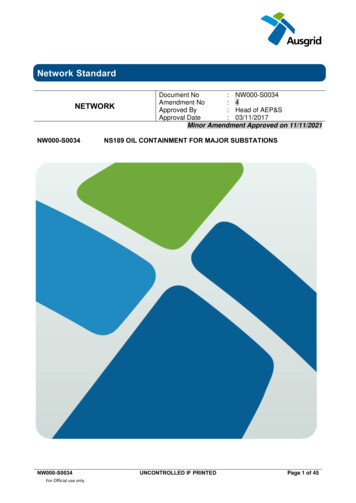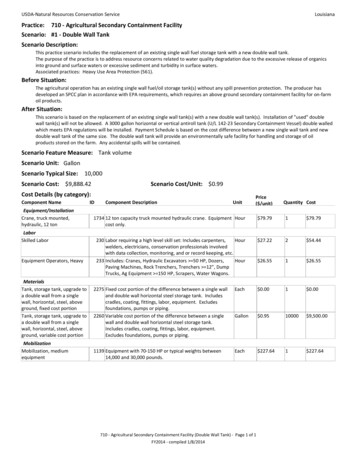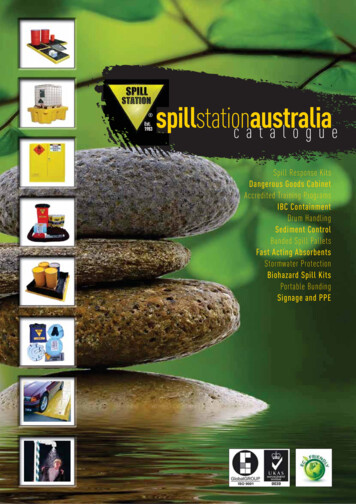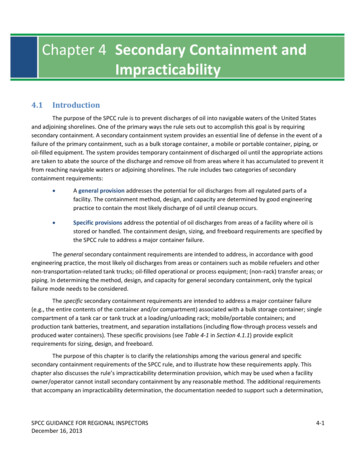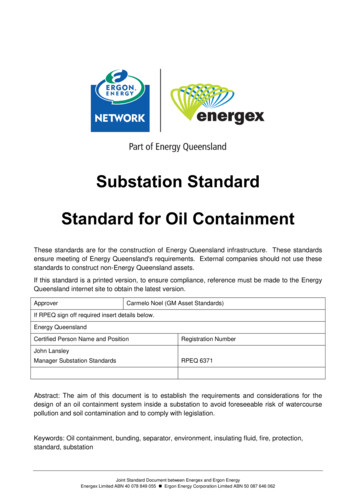
Transcription
Substation StandardStandard for Oil ContainmentThese standards are for the construction of Energy Queensland infrastructure. These standardsensure meeting of Energy Queensland's requirements. External companies should not use thesestandards to construct non-Energy Queensland assets.If this standard is a printed version, to ensure compliance, reference must be made to the EnergyQueensland internet site to obtain the latest version.ApproverCarmelo Noel (GM Asset Standards)If RPEQ sign off required insert details below.Energy QueenslandCertified Person Name and PositionRegistration NumberJohn LansleyManager Substation StandardsRPEQ 6371Abstract: The aim of this document is to establish the requirements and considerations for thedesign of an oil containment system inside a substation to avoid foreseeable risk of watercoursepollution and soil contamination and to comply with legislation.Keywords: Oil containment, bunding, separator, environment, insulating fluid, fire, protection,standard, substationJoint Standard Document between Energex and Ergon EnergyEnergex Limited ABN 40 078 849 055 Ergon Energy Corporation Limited ABN 50 087 646 062
Standard for Oil ContainmentFor definitive document version and control detail, please refer to the information stored on theProcess Zone.Revision historyRevision date13/7/2021Versionnumber1.0AuthorSubstation DesignStandardsDescription of change/revisionSS-1-9.2 has been superseded bySTNW3036; Ver 1.0.References revised and updated.Standard has been aligned with latestversion of AS 2067.Standard has developed to combineErgon and Energex practices.Check this is the latest version before useiiJoint Standard Document between Energex and Ergon EnergyEnergex Limited ABN 40 078 849 055 Ergon Energy Corporation Limited ABN 50 087 646 062EX 02143 Ver 1EE STNW3036 Ver 1
Standard for Oil ContainmentTable of Contents12Overview . 11.1Purpose . 11.2Scope . 1References . 12.1EQL controlled documents . 12.2Other documents . 23Legislation, regulations, rules, and codes . 24Definitions and abbreviations . 34.1Definitions . 34.2Abbreviations . 45Authorities and responsibilities . 46Existing oil containment facilities . 47Environmental risk assessment . 58Design Principles . 59Selection of oil containment solution . 69.1Oil containment selection process . 69.2Total containment . 79.3Secondary containment . 79.4Oil-water separation system . 79.4.19.5Fail-safe system . 8Alarms and Indication. 910 General design requirements. 910.1 General . 910.2 New bund designs . 910.2.1Bund walls and floor . 1010.2.2Bund drainage system design . 1110.2.3Clearances, access and egress. 1210.2.4Cable entry . 1210.3 Separation system sampling/test points . 1210.4 Mobile substations . 1210.5 Transformers in storage . 1210.6 Temporary bund. 1310.7 Synthetic and natural ester fluids . 1310.8 Deviations from this standard . 1311 Documentation required . 13Annex AExamples of types (informative) . 15Annex A.1 Existing systems in the network . 15Annex A.2 Hydrocarbon filters/socks . 16Annex A.3 Background information on the popular separation methods . 16Check this is the latest version before useiiiJoint Standard Document between Energex and Ergon EnergyEnergex Limited ABN 40 078 849 055 Ergon Energy Corporation Limited ABN 50 087 646 062EX 02143 Ver 1EE STNW3036 Ver 1
Standard for Oil Containment1 Overview1.1PurposePower transformers, oil-filled reactors and large regulators are the greatest potential source ofmajor oil spills in substations, since they typically contain the largest quantity of oil. Spills may becaused by electrical failure, leaks, vandalism, sabotage, or accident.All insulating fluids, even those that are non-toxic and readily biodegradable, can damage theenvironment, so any spills must be contained within the substation.This document describes the requirements and considerations for the design of an oil containmentsystem inside a substation to avoid foreseeable watercourse pollution risk and soil contaminationand to comply with legislation.1.2ScopeThis standard shall be applied to all high voltage installations within an Energy Queenslandsubstation that contain equipment with a total of more than 1000 litres of an insulating liquid.1This standard shall also be followed where equipment containing less than 1000 litres of insulatingliquid requires oil containment, typically as an outcome from an environmental risk assessment.Excluded from this standard are: Fuel/oil storage installations Pad mounted and pole mounted transformers used for local supply services. Instrument transformers, circuit breakers, and similar items in an outdoor switchyard. 2Oil containment is intended to capture inadvertent leaks from plant and equipment. The repair ofleaking equipment shall always be considered as the first course of action when addressing themitigation and control of an oil spill.This standard also covers the requirements for oil-water separators used in conjunction with oilcontainment systems. These systems treat oil-water mixtures from a containment system prior towater discharge.2 ReferencesThe environmental risk assessment and design of an oil containment system is generally inaccordance with the following publications. Refer to the standards listed in the table below for allundated standards referenced in this document.2.1EQL controlled documentsDocument number or location(if applicable)R271Document nameEQL Risk Management GuideDocument typeStandard1According to Section 6.8 of AS2067, every indoor and outdoor high voltage installation containing equipment with more than 1000 L ofan insulating liquid such as transformer insulating oil shall have provision for containing the total volume of any possible leakage.2These are exempted from compliance as per Appendix G Clause G4 of AS 1940Check this is the latest version before usePage 1Joint Standard Document between Energex and Ergon EnergyEnergex Limited ABN 40 078 849 055 Ergon Energy Corporation Limited ABN 50 087 646 062EX 02143 Ver 1EE STNW3036 Ver 1
Standard for Oil ContainmentDocument number or location(if applicable)Document nameDocument typeR056EQL Risk Evaluation MatrixStandardSTNW3035EQL Standard for Fire andExplosion ProtectionStandardRED1909 STNW3013EQL Clearances in AirStandardNT-1555EQL Oil Spill Clean-UpOperational UpdateLOSTD-CV002 (all sheets)EGX Standard Civil, Drainage(various)Standard drainage drawingsDocument number or location(if applicable)Document nameDocument typeAS 1530.4:2014Methods for fire tests on buildingmaterials, components andstructures – combustibility test formaterialsAustralian StandardAS 1940:2017The storage and handling offlammable and combustible liquidsAustralian StandardAS 2067:2016Substations and high voltageinstallations exceeding 1 kV a.cAustralian StandardAS/NZS ISO 14001, 2016Environmental managementsystems – Requirements withguidance for useAustralian inesAustralian and New ZealandGuidelines for Fresh and MarineWater au/ data/assets/pdf uideline - Stormwater andenvironmentally relevant activities(Qld Dept of Environment &Science)Guideline2.2Other documents3 Legislation, regulations, rules, and codesThis document refers to the following:Legislation, regulations, rules, and codesEnvironmental Protection Act 1994. Queensland GovernmentElectrical Safety Act, 2002. Queensland GovernmentElectrical Safety Regulation, 2013. Queensland GovernmentElectricity Act, 1994. Queensland GovernmentCheck this is the latest version before usePage 2Joint Standard Document between Energex and Ergon EnergyEnergex Limited ABN 40 078 849 055 Ergon Energy Corporation Limited ABN 50 087 646 062EX 02143 Ver 1EE STNW3036 Ver 1
Standard for Oil ContainmentLegislation, regulations, rules, and codesElectricity Regulation, 2006. Queensland GovernmentWork Health and Safety Act, 2011. Queensland GovernmentWork Health and Safety Regulation, 2011. Queensland GovernmentNational Electricity Rules, 2018. Australian Energy Market Commission4 Definitions and abbreviations4.1DefinitionsFor the purposes of this standard, the following definitions apply:TermDefinitionBundA wall or embankment which may form part or all the perimeter of a compound.[SOURCE: AS 1940:2017, 1.4.5]CompoundAn area bounded by a bund or ground contours intended to retain spillage orleakage. This includes the floor of the compound. Later referred to as "spillagecontainment compound" or "oil spill containment facility". [SOURCE: AS1940:2017, 1.4.12, modified]Containment systemTank and or bund around equipment to prevent the escape of insulating liquid.[SOURCE: AS 2067:2016, 1.4.11] Also known as bunding and oil separationsystem. A containment system includes some combination of bund (always),sump, flame trap, oil-water separator, secondary oil containment.Energy QueenslandsubstationRefers to bulk supply, zone or C&I substations owned by Ergon Energy orEnergex DNSP’s. Excludes assets owned by Yurika.Fire fightingEither manual or automatic or a combination of the two.Flame trapA liquid seal used to prevent the passage of flame through a drain.Insulating fluidAll types of insulating fluid including mineral oil and ester fluids (O, K type).LiquidsWhere the word liquids is used without further qualification, it includes bothflammable and combustible liquids.Mobile substationsWhere the word mobile substation is used, it includes Ergon Energy Nomad andEnergex mobile substations, and SKID designs.Oil-water separatorA system to separate insulating fluid from water comprising a sludge trap, an oilseparator, and a sampling/test point. May also be referred to as an oil arrestor oroil interceptor.Remote supervisionTo remotely monitor the functions of the oil containment system. Eg, bund / oilwater separator fluid level, status of mechanical equipment.Sensitive environmentThe term includes, but is not limited to—(a) a water catchment area;(b) a reservoir for drinking water;(c) a freshwater or marine environment; and(d) a national park or equivalent.Check this is the latest version before usePage 3Joint Standard Document between Energex and Ergon EnergyEnergex Limited ABN 40 078 849 055 Ergon Energy Corporation Limited ABN 50 087 646 062EX 02143 Ver 1EE STNW3036 Ver 1
Standard for Oil ContainmentTermDefinitionTransformerTransformer, reactor or regulatorWatercourseThis term includes, but is not limited to: river, creek, stream, wetland, drainagepath, or inlet of the sea.4.2AbbreviationsThe following acronyms appear in this standard.AcronymDefinitionARIAverage Recurrence IntervalEQLEnergy Queensland LimitedFRLFire-resistance level in accordance with AS 1530.4:2014.PCBPolychlorinated biphenyls.RPEQRegistered Professional Engineer of QueenslandSCADASupervisory control and data acquisition5 Authorities and responsibilitiesThe responsibility for the management of oil containment devices at EQL is as follows:Table 5-1 List of teams and associated responsibilities for oil containmentAuthorityResponsibilitiesAsset StandardsSubstation Standard for Oil ContainmentEstablish oil-water separator minimum discharge performanceAsset MaintenancePerformance and maintenance of existing devicesBunding Defect ProgramEnvironmentalSpecialistReview of environmental controls and legal obligationsSubstation DesignCivil Engineering RPEQSite-specific application of this standard, including performing the environmentalrisk assessment.6 Existing oil containment facilitiesThis standard does not mandate upgrade of existing oil containment facilities. Repair or like for likereplacement may be to the standard of the existing facility. Where a change requiring more than10% difference to the existing oil containment facility is required the whole facility is to be broughtinto compliance with this standard.Check this is the latest version before usePage 4Joint Standard Document between Energex and Ergon EnergyEnergex Limited ABN 40 078 849 055 Ergon Energy Corporation Limited ABN 50 087 646 062EX 02143 Ver 1EE STNW3036 Ver 1
Standard for Oil Containment7 Environmental risk assessmentWhere necessary, an environmental risk assessment is to be undertaken, in consultation with anEnergy Queensland Environmental Specialist, at any site where insulating fluids in excess of 1000litres are contained or located in an environmentally sensitive environment.A risk assessment shall be made as set out in Energy Queensland's R271 - Risk ManagementGuide.8 Design PrinciplesThe overriding principle of a substation oil containment system is that it prevents oil escape fromthe substation, whether it be from leaky or ruptured plant.Substation oil containment systems shall be designed in accordance with the requirementsspecified in AS 2067 and in relevant parts of AS 1940.Any major plant item containing oil with a volume exceeding 1000 litres, shall be installed in adedicated bund.If the concentration of PCB in oil requiring a containment system exceeds 2 ppm, consult anEnvironmental Specialist.3The minimum capacity of a bund shall be 110% of the associated equipment's total oil volumetogether with firefighting water for 20 min as per AS 2067 4. For outdoor installations, the volumeof rainwater collected in a 20-year ARI rainfall event (in 24 hours) shall also be considered indetermining the final bund volume.For installations where water can enter the bund, the bund shall drain into a suitable oil-waterseparator prior to discharge. The performance criteria of oil-water separators are set-out inSection 9.4.For installations (typically indoor) where minimal rainwater can enter the bund, oil capture by totalcontainment, typically to a dump tank, is preferred over an oil-water separator.Multiple power and auxiliary transformers shall not be contained within a single common bund.Earthing transformers associated with a power transformer may be installed within a commonbund.Secondary containment bunds can add capacity to supplement upstream bunds for instance wherethe primary/upstream bund may not be able to meet the 110% requirement. The main advantage isto mitigate fire risk by distancing combustible liquid from the most likely source of ignition. Multipleequipment bunds may be drained via segregated pipes and flame traps to a common secondarycontainment bund.The impact on the adjacent plant, properties (e.g. buildings), structures, fire walls, stormwater,sewer lines, the effect of firefighting facility and requirements for ventilation, access formaintenance, testing, etc., shall be considered. These aspects will directly affect the bund designsand location of the oil collector/oil-water separator.3No oil or regulated waste containing any polychlorinated biphenyls (PCBs) in concentrations greater than 2 parts per million or relatedhalogenated polyaromatic substances is to be treated on site (Environmental Protection Act 1994).4Firefighting systems will typically deliver 10 L/s (600 L/min). Actual rates specific to the installation are to be used.Check this is the latest version before usePage 5Joint Standard Document between Energex and Ergon EnergyEnergex Limited ABN 40 078 849 055 Ergon Energy Corporation Limited ABN 50 087 646 062EX 02143 Ver 1EE STNW3036 Ver 1
Standard for Oil ContainmentThe design of the bund shall ensure a safe work area and facilitate egress for personnel inaccordance with access requirements in AS 2067 and STNW3013.All new oil containment systems or modifications to existing systems shall be subject to theapproval by the responsible RPEQ.Whilst the containment and oil-water separator systems generally carry stormwater only, they havethe potential to carry hot oil from a transformer fire that may equal or exceed the auto-ignitiontemperatures for mineral oil (up to 400OC). In the event of a transformer fire the containmentsystem and oil-water separator system will need inspection to confirm they remain operational priorto return to service.9 Selection of oil containment solution9.1Oil containment selection processThe following flow chart shall be used to assist in designing the correct oil containment system foran individual site/installation. The total cost of ownership of each potential solution shall beconsidered, including the purchase price, maintenance and other operating costs. The lowest totalcost of ownership solution is preferred.Check this is the latest version before usePage 6Joint Standard Document between Energex and Ergon EnergyEnergex Limited ABN 40 078 849 055 Ergon Energy Corporation Limited ABN 50 087 646 062EX 02143 Ver 1EE STNW3036 Ver 1
Standard for Oil ContainmentThere are two fundamentally different approaches: A total containment system holds spilt oil, usually in a transformer room bund or a dumptank, until it is removed from the site by a tanker truck. An oil-water separation system collects spilt oil deliberately and stormwater incidentally,separates the two and discharges the treated water.9.2Total containmentTotal containment is only practical where minimal rainwater can infiltrate into the oil containmentsystem, typically where equipment is located indoors. The performance criterion for a totalcontainment system is that it must never leak or overflow. A dump tank that receives oil from morethan one transformer must have a minimum volume of 110% of the largest transformer volume. Amobile tanker will typically be required to pump out the spilt liquid from the tank.9.3Secondary containmentSecondary oil containment may be used to supplement the capacity of upstream bunds that arenot of sufficient capacity. Secondary containment can also be used to minimise the risk of an oilfire burning within a bund. Consideration shall be given to the consequences of an oil fire within abund that may impact adjacent equipment (e.g. power transformers, HV busbars and associatedequipment, buildings, etc). If this results in significant damage to the network, secondarycontainment measures shall be considered in minimising this risk.Secondary containment can be in the form of underground tanks, usually directly below thetransformer compound, or a separate bund typically located at a sufficient distance away from thetransformer compounds and other switchyard equipment. These systems shall be connected tothe primary containment systems in accordance with this standard. Where a secondarycontainment system is installed, it shall drain into an oil-water separator.9.4Oil-water separation systemThe performance criteria for oil-water separation systems relate to the quality of the discharge andthe reliability of the system.The options for discharge from the oil-water separator in order of preference shall be: Discharge to the ground Discharge to stormwater Discharge to sewerage as trade waste.Discharge to a sewer may require approval of the sewerage service provider. Methods of oil-waterseparation acceptable to sewerage service providers include: coalescing plate separators; membrane technology; dissolved air flotation (DAF); chemical precipitation; hydrocyclones; and other apparatus /methods.Check this is the latest version before usePage 7Joint Standard Document between Energex and Ergon EnergyEnergex Limited ABN 40 078 849 055 Ergon Energy Corporation Limited ABN 50 087 646 062EX 02143 Ver 1EE STNW3036 Ver 1
Standard for Oil ContainmentSome of these may also meet the water quality performance levels suitable for discharge to theenvironment.Any discharge from a fully functioning separation system to the environment shall have thefollowing: no visible oil sheen, and almost transparent clarityUnder all operating conditions, the oil-water separator minimum discharge performance shall be inaccordance with the table below:Table 9-1 - Oil-water separator discharge performance Oil to environmentNo oil sheen on treated water 10 ppm oil in outlet water (5 ppm preferredfor environmentally sensitive locations)Oil to sewerNone 30 ppm oil in outlet waterSuspended SolidsTransparent to cloudyBlack-on-white Arial 10-point is legible through100 mmDebris, litterNoneZeroThe discharge from the oil-water separator to the environment shall be directed on to the bareground or gravel within the substation. The discharge shall be directed away from sewers,stormwater pipes, pits or drains. Site drainage shall be arranged to avoid long term ponding orerosion.The existing types of oil-water separation systems used in Energy Queensland substations arevertical or horizontal drum type, vertical water column or proprietary systems. The selected systemdesign shall include all low-cost measures that improve reliability.Annex A contains a list of separation systems and technology. Alternative oil-water separators willbe considered subjected to a risk assessment and approval by an RPEQ.9.4.1 Fail-safe systemA fail-safe system is meant to be inherently safe, ensuring no discharge under contemplatedoperation.A fail-safe system is required when the site is located in or upstream of an environmentallysensitive area. A fail-safe system may also be used where there is insufficient space for aseparator sized to hold all of oil from the largest transformer it serves. When combined with the riskof this coinciding with a major oil spill or heavy rainfall, the probability of an oil release is extremelylow.Design measures contributing to a fail-safe system include: Inlet of pipe to separator from within compound located higher than top of the bund.Check this is the latest version before usePage 8Joint Standard Document between Energex and Ergon EnergyEnergex Limited ABN 40 078 849 055 Ergon Energy Corporation Limited ABN 50 087 646 062EX 02143 Ver 1EE STNW3036 Ver 1
Standard for Oil Containment Low flow rate, float switch operated, non-emulsifying, discharge pump installed in a sumpwithin the compound, the outlet of which discharges into the pipe feeding the separator.Pump discharge must not be greater than the capacity of the separator. The separator may be smaller than that required to hold all of oil from the largesttransformer it serves Low voltage power supply to the pump via transformer protection trip relays such that anyrelay operation results in de-energisation of the pumpElectrically operated control valves/gates shall not be used as part of a fail-safe system.9.5Alarms and IndicationAlarms shall be provided to indicate levels of oil and/or water contained within a particular system.Dump tanks and sumps shall be fitted with float switches indicating low (10% of volume) and highlevels (70% of volume) of fluid containment. Consideration shall be given to the setting of the alarmlevels based on the final design solution. Pumps and other mechanical systems relating to the oilcontainment system shall also be monitored. Where pumps are installed, a bund level alarm shallbe installed to monitor operation of the system; normal operation of rainwater buffering is not toinstigate an alarm. The transformer cooling system shall be disabled upon operation of atransformer protection trip.Oil-water separators may be supplied from the manufacturer with multiple alarm options. Forunderground horizontal tank oil-water separators, a ‘high oil level’ alarm (or equivalent) isacceptable. Other available alarms are generally not required. For all oil-water separators, anymonitoring equipment, such as control boards and sensors shall be monitored by the use of awatchdog contact where available. All alarms are to be wired to the substation SCADA system.10 General design requirements10.1 GeneralThis section specifies the general requirements and considerations for the design of a bund. Bundsshall be designed in accordance with this standard and the relevant sections of AS 2067 andAS 1940.10.2 New bund designsThis section applies to any new bund installed in a greenfield application. If applicable, this sectionmay apply to new bunds or bunds requiring refurbishment in brownfield applications, where siteconstraints or future works may require alternative solutions.A minimum clearance of 1000 mm between the transformer extents (including radiators, pipework,cubicles etc.) and the inside of the bund wall is required to allow sufficient access within thecompound. A minimum 600mm is to be provided between open cubicle doors and bund wall.The area of the bund shall be designed using the outline of the outer profile of the unit, to be ableto capture all oil ejected from pressure relief devices, ruptured bushing turrets, main tank, coolingsystem and the conservator.Check this is the latest version before usePage 9Joint Standard Document between Energex and Ergon EnergyEnergex Limited ABN 40 078 849 055 Ergon Energy Corporation Limited ABN 50 087 646 062EX 02143 Ver 1EE STNW3036 Ver 1
Standard for Oil ContainmentThe design shall allow for a spill angle of 26.5o taken from the top of the transformer, includingradiators. Transformer conservators, bushing turrets shall be considered when performing spillangle calculations. Where these components significantly alter the spill angle and resulting bunddimensions, consideration shall be given to the final bund wall location relative to the transformeron a case by case basis. Refer Figure 3 in Appendix for details.If spray screens are required where the crest locus limit cannot be practically met, the design shallensure adequate ventilation is still maintained.Delivery, installation and decommissioning of the transformer/regulator must be considered in thedesign of the bund. This shall include but not be limited to access for the crane and truck, slewpaths, overhead restrictions and crane outrigger placement.Bund capacity shall accommodate future needs by allowing for the largest anticipated transformerand any spare that could be installed at the site. Listed below are approximate oil volumes forpreviously contracted transformers. Actual oil volumes with appropriate safety factors should beused to determine bund volume.Table 10-1 Approximate transformer oil volumesTransformer SizeTypical oil volume (litres)8 MVA 33/11 kV7,0006.3 MVA 66/11 kV, 10 MVA 66/11 kV, 15 MVA 33/11 kV10,00020 MVA 66/11 kV, 25 MVA 33/11 kV14,00025 MVA 66/22 kV, 32 MVA 66/11 kV18,00032 MVA 132/11 kV, 32 MVA 132/22 kV, 40 MVA 33/11 kV19,00040 MVA 132/66/11 kV, 63 MVA 132/22 kV, 63 MVA 132/1
Oil containment is intended to capture inadvertent leaks from plant and equipment. The repair of leaking equipment shall always be considered as the first course of action when addressing the mitigation and control of an oil spill. This standard also covers the requirements for oil-water separators used in conjunction with oil containment systems.

